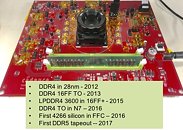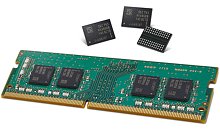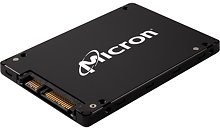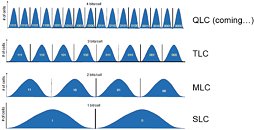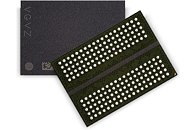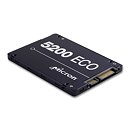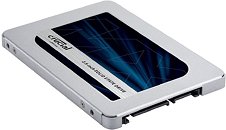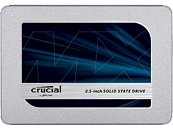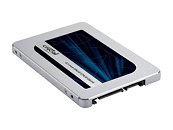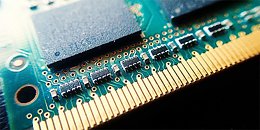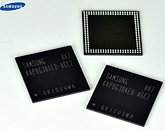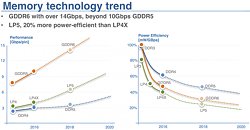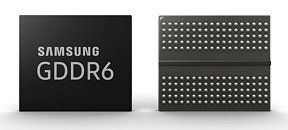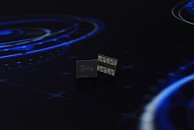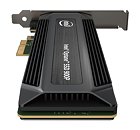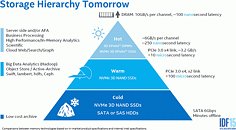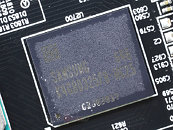Apr 1st, 2025 23:32 EDT
change timezone
Latest GPU Drivers
New Forum Posts
- PCB serial number explanation Asrock rx5700xt Taichi oc+ (8)
- What do you do for a living? (477)
- Adding 2 more sticks of DDR5 Ram 64gb for a total of 4 (68)
- RTX 3090 is still a good card? (28)
- Thanks for locking my thread with a legitimate question because it's april fools day (2)
- How to quickly & easily fix coil-whine(coil choke noise) (1150)
- X670 owners, what kind of PCH temps do you you see? (28)
- Help me improve performance possibly (0)
- Windows 11 General Discussion (5913)
- Is the futureproof gaming solution a four drive system? (43)
Popular Reviews
- DDR5 CUDIMM Explained & Benched - The New Memory Standard
- Sapphire Radeon RX 9070 XT Pulse Review
- SilverStone Lucid 04 Review
- ASRock Phantom Gaming B850 Riptide Wi-Fi Review - Amazing Price/Performance
- Palit GeForce RTX 5070 GamingPro OC Review
- Gigabyte GeForce RTX 5080 Gaming OC Review
- Sapphire Radeon RX 9070 XT Nitro+ Review - Beating NVIDIA
- Samsung 9100 Pro 2 TB Review - The Best Gen 5 SSD
- Assassin's Creed Shadows Performance Benchmark Review - 30 GPUs Compared
- be quiet! Pure Rock Pro 3 Black Review
Controversial News Posts
- MSI Doesn't Plan Radeon RX 9000 Series GPUs, Skips AMD RDNA 4 Generation Entirely (146)
- Microsoft Introduces Copilot for Gaming (124)
- AMD Radeon RX 9070 XT Reportedly Outperforms RTX 5080 Through Undervolting (119)
- NVIDIA Reportedly Prepares GeForce RTX 5060 and RTX 5060 Ti Unveil Tomorrow (115)
- Over 200,000 Sold Radeon RX 9070 and RX 9070 XT GPUs? AMD Says No Number was Given (100)
- NVIDIA GeForce RTX 5050, RTX 5060, and RTX 5060 Ti Specifications Leak (96)
- Retailers Anticipate Increased Radeon RX 9070 Series Prices, After Initial Shipments of "MSRP" Models (90)
- China Develops Domestic EUV Tool, ASML Monopoly in Trouble (88)
News Posts matching #Micron
Return to Keyword Browsing
Micron Ships Industry's First Quad-Level Cell NAND SSD
Micron Technology, Inc. has commenced shipments of the industry's first SSD built on revolutionary quad-level cell (QLC) NAND technology. Unveiled at Micron's 2018 Analyst and Investor Event, the Micron 5210 ION SSD provides 33 percent more bit density than triple-level cell (TLC) NAND, addressing segments previously serviced with hard disk drives (HDDs). The introduction of new QLC-based SSDs positions Micron as a leader in providing higher capacity at lower costs to address the read-intensive yet performance-sensitive cloud storage needs of AI, big data, business intelligence, content delivery and database systems.
As workloads evolve to meet the ever-increasing demands for real-time data insights and analytics, data centers increasingly need the capacity, speed, reliability and steady state performance that enterprise flash storage provides. Micron QLC NAND - reaching densities of 1 terabit with its next-generation 64-layer 3D NAND structure - is optimized to meet these demands and make SATA SSD performance and capacity more approachable than ever before.
As workloads evolve to meet the ever-increasing demands for real-time data insights and analytics, data centers increasingly need the capacity, speed, reliability and steady state performance that enterprise flash storage provides. Micron QLC NAND - reaching densities of 1 terabit with its next-generation 64-layer 3D NAND structure - is optimized to meet these demands and make SATA SSD performance and capacity more approachable than ever before.

Micron and Intel Extend Their Leadership in 3D NAND Flash Memory
Micron Technology Inc. and Intel Corporation today announced production and shipment of the industry's first 4bits/cell 3D NAND technology. Leveraging a proven 64-layer structure, the new 4bits/cell NAND technology achieves 1 terabit (Tb) density per die, the world's highest-density flash memory. The companies also announced development progress on the third-generation 96-tier 3D NAND structure, providing a 50 percent increase in layers. These advancements in the cell structure continue the companies' leadership in producing the world's highest Gb/mm2 areal density.
Both NAND technology advancements-the 64-layer QLC and 96-layer TLC technologies -utilize CMOS under the array (CuA) technology to reduce die sizes and deliver improved performance when compared to competitive approaches. By leveraging four planes vs the competitors' two planes, the new Intel and Micron NAND flash memory can write and read more cells in parallel, which delivers faster throughput and higher bandwidth at the system level. The new 64-layer 4bits/cell NAND technology enables denser storage in a smaller space, bringing significant cost savings for read-intensive cloud workloads. It is also well-suited for consumer and client computing applications, providing cost-optimized storage solutions.
Both NAND technology advancements-the 64-layer QLC and 96-layer TLC technologies -utilize CMOS under the array (CuA) technology to reduce die sizes and deliver improved performance when compared to competitive approaches. By leveraging four planes vs the competitors' two planes, the new Intel and Micron NAND flash memory can write and read more cells in parallel, which delivers faster throughput and higher bandwidth at the system level. The new 64-layer 4bits/cell NAND technology enables denser storage in a smaller space, bringing significant cost savings for read-intensive cloud workloads. It is also well-suited for consumer and client computing applications, providing cost-optimized storage solutions.

Cadence and Micron Demo DDR5-4400 Memory Module
Cadence and Micron have joined forces to build the world's first working DDR5-4400 memory module. Cadence provided their DDR5 memory controller and PHY for the prototype while Micron produced the 8 Gb chips, which were manufactured under TSMC's 7 nm process. They were able to achieve 4400 megatransfers per second, which is roughly 37.5% faster than the fastest DDR4 memory that is currently on the market. Nevertheless, Marc Greenberg from Cadence emphasized that DDR5 aims to provide increased capacity solutions, more than actual performance.
The DDR5 standard should facilitate the production of 16 Gb dies and make vertical stacking easier. Restricted by laws of physics, dies eventually get slower as they increased in size. Once you start putting 16Gb die in 1X memory technology, the distances between them starts to get longer. As a result, core timing parameters become worse. Cadence's prototype had a CAS latency of 42 (No, not a typo). Although, the test module does run at 1.1 volts, which makes it quite impressive when compared to DDR4.
The DDR5 standard should facilitate the production of 16 Gb dies and make vertical stacking easier. Restricted by laws of physics, dies eventually get slower as they increased in size. Once you start putting 16Gb die in 1X memory technology, the distances between them starts to get longer. As a result, core timing parameters become worse. Cadence's prototype had a CAS latency of 42 (No, not a typo). Although, the test module does run at 1.1 volts, which makes it quite impressive when compared to DDR4.

Samsung, Micron, and Hynix Accused of DRAM Price Fixing
Law firm Hagens Berman has filed a class action lawsuit against Samsung, Micron, and Hynix in the US District Court for the Northern District of California. According to the firm's investigation, the three DRAM manufacturers conspired to limit the supply of DRAM chips between 2016 and 2017 with the purpose of inflating their prices. The firm affirmed that DRAM saw a 47 percent increase in price during 2017, which made it the largest jump ever in the last 30 years. As noted by the filing, Samsung, Micron and Hynix collectively own 96 percent of the worldwide DRAM market as of 2017. The "conduct changed abruptly" when the Chinese government launched an investigation to look into the matter. This class action is opened to consumers in the U.S. who've purchased a device that uses DRAM between July 1, 2016 and February 1, 2018.
"What we've uncovered in the DRAM market is a classic antitrust, price-fixing scheme in which a small number of kingpin corporations hold the lion's share of the market," stated Hagens Berman managing partner Steve Berman. "Instead of playing by the rules, Samsung, Micron and Hynix chose to put consumers in a chokehold, wringing the market for more profit."
"What we've uncovered in the DRAM market is a classic antitrust, price-fixing scheme in which a small number of kingpin corporations hold the lion's share of the market," stated Hagens Berman managing partner Steve Berman. "Instead of playing by the rules, Samsung, Micron and Hynix chose to put consumers in a chokehold, wringing the market for more profit."

Micron Announces New Edge Storage MicroSDXC Cards
Micron today announced general availability of the 128GB and 256GB density of edge storage microSD card solutions and collaboration with several leading video surveillance solution providers to promote surveillance-grade edge storage. Built on Micron's industry-leading 64-layer 3D TLC NAND technology, the newly released solutions enable greater capacity in a smaller space, delivering up to 30 days of surveillance video storage in the camera itself.
Over 98 percent of all microSD cards sold globally in 2017 were used in consumer applications, according to IHS Markit. These consumer-grade memory cards are not designed and validated for commercial use in video surveillance applications. Micron's industrial microSD cards are designed specifically for professional video surveillance use cases and include a three-year warranty for 24x7 continuous video recording usage. The Micron microSD card design and firmware is optimized to ensure a reliable, robust and low-maintenance system design that delivers 24x7 continuous recording capability with minimum video frame drops.
Over 98 percent of all microSD cards sold globally in 2017 were used in consumer applications, according to IHS Markit. These consumer-grade memory cards are not designed and validated for commercial use in video surveillance applications. Micron's industrial microSD cards are designed specifically for professional video surveillance use cases and include a three-year warranty for 24x7 continuous video recording usage. The Micron microSD card design and firmware is optimized to ensure a reliable, robust and low-maintenance system design that delivers 24x7 continuous recording capability with minimum video frame drops.

Micron To Release QLC NAND-Based Drives in 2018 to the Server Environment
Micron has announced that they will be introducing QLC (Quad Level Cell) NAND-based, own brand drives for the server environment this year. The new QLC drives are expected to boost maximum storage density (and price per GB) closer to that of mechanical HDDs, which is why Micron is positioning drives based on this memory technology as data center-class SSDs for the nearline storage market. The company is positioning these drives as replacement options for 7,200 RPM HDDs for workloads that require heavy reads of stored information - thus offsetting QLC NAND's lower endurance when it comes to available maximum writes on the drives' cells.
It's a known trade-off when it comes to the NAND world: higher amounts of bits per cell to represent information means that there must be much increased accuracy when it comes to reading a given cell's voltage state. While SLC NAND only tracks two voltage states, MLC (2-bits per cell) tracks four voltage states, TLC doubles that to eight voltage states, and QLC doubles the ante again for a maximum 16 voltage states, where each voltage state represents data on the cell. Of course, with repeat writes and voltage changes, accuracy and capacity for the cell to maintain its given voltage tend to drop, which leads to incorrect information and thus corrupted data or those cells to be rendered inoperative. This is one of the reasons for manufacturers to include overprovisioning in their NAND-based solutions.
It's a known trade-off when it comes to the NAND world: higher amounts of bits per cell to represent information means that there must be much increased accuracy when it comes to reading a given cell's voltage state. While SLC NAND only tracks two voltage states, MLC (2-bits per cell) tracks four voltage states, TLC doubles that to eight voltage states, and QLC doubles the ante again for a maximum 16 voltage states, where each voltage state represents data on the cell. Of course, with repeat writes and voltage changes, accuracy and capacity for the cell to maintain its given voltage tend to drop, which leads to incorrect information and thus corrupted data or those cells to be rendered inoperative. This is one of the reasons for manufacturers to include overprovisioning in their NAND-based solutions.

Micron and Industry Partners to Deliver Comprehensive GDDR6 Solutions
Micron Technology, Inc., a leading memory and storage provider, today announced with Rambus Inc., Northwest Logic and Avery Design, their efforts to deliver a comprehensive solution for GDDR6, the world's fastest discrete memory. This first-of-its-kind solution would enable GDDR6 use in advanced applications such as high-performance networking, autonomous vehicles, artificial intelligence and 5G infrastructure. Prior generations of GDDR memories, enabled by GPU vendors, were focused exclusively on the graphics market. While this allowed graphics and game console designs to take advantage of the significant performance advantage offered by GDDR, other applications could not because the necessary building blocks were not available.

Micron Launches 5200 Series Enterprise SATA SSDs Utilizing 64-Layer 3D TLC NAND
Micron Technology, Inc. today launched the Micron 5200 series of SATA solid state drives (SSDs), maintaining industry-leading performance, consistency, capacity, reliability, and overall infrastructure value. Built on Micron's new industry-leading 64-layer 3D NAND technology, the Micron 5200 series of SSDs offers a cost-optimized SATA platform for business-critical virtualized workloads that cripple on a hard drive, such as OLTP, BI/DSS, VDI, block/object and media streaming.
Leveraging the proven architecture, performance and capacity of the well-regarded 5100 SATA SSDs, the Micron 5200 series is engineered to deliver a fast, easy and cost-effective enterprise storage solution to replace existing hard drives and legacy SSDs. Micron 5200 SSDs immediately deliver better total cost of ownership and improve data center efficiency through server and storage platform consolidation, reducing IT costs and simplifying infrastructure and maintenance. Now it is easier than ever before for enterprises to add more flash into the data center and get more out of server deployments.
Leveraging the proven architecture, performance and capacity of the well-regarded 5100 SATA SSDs, the Micron 5200 series is engineered to deliver a fast, easy and cost-effective enterprise storage solution to replace existing hard drives and legacy SSDs. Micron 5200 SSDs immediately deliver better total cost of ownership and improve data center efficiency through server and storage platform consolidation, reducing IT costs and simplifying infrastructure and maintenance. Now it is easier than ever before for enterprises to add more flash into the data center and get more out of server deployments.

Crucial Starts Selling MX500 2.5-inch SSD Models
Crucial started selling all four models of its premium SATA SSD, the MX500. The drive was launched earlier this month. It comes in 250 GB, 500 GB, 1 TB, and 2 TB variants; and in the 2.5-inch form-factor, with SATA 6 Gbps interface. M.2-2280 variants with SATA interface, which were shown off at the 2018 International CES, could launch a little later this year. The 250 GB variant is priced (MSRP) at USD $79.99 ($0.31 per GB), the 500 GB variant at $139.99 ($0.27 per GB), the 1 TB variant $259.99 ($0.25 per GB), and the range-topping 2 TB variant $499.99 ($0.24 per GB). All four models come with 5-year warranties.
Crucial MX500 combines Micron's 2nd generation 64-layer 3D TLC NAND flash memory with a Silicon Motion SM2258 controller, and a custom firmware by Crucial. The NAND flash chips by design offer the same levels of power-loss protection as drives that need capacitor banks to do so. Among its features are Dynamic Write Acceleration (SLC-cached writes), and Redundant Array of Independent NAND (RAIN). All four variants offer sequential transfer rates of up to 560 MB/s with up to 510 MB/s writes, and 4K random access performance ratings of up to 95,000/91,000 IOPS (reads/writes).
Crucial MX500 combines Micron's 2nd generation 64-layer 3D TLC NAND flash memory with a Silicon Motion SM2258 controller, and a custom firmware by Crucial. The NAND flash chips by design offer the same levels of power-loss protection as drives that need capacitor banks to do so. Among its features are Dynamic Write Acceleration (SLC-cached writes), and Redundant Array of Independent NAND (RAIN). All four variants offer sequential transfer rates of up to 560 MB/s with up to 510 MB/s writes, and 4K random access performance ratings of up to 95,000/91,000 IOPS (reads/writes).

Crucial Launches the MX500 Solid State Drive
Crucial, a leading global brand of memory and storage upgrades, today announced the availability of the Crucial MX500 SSD. The new drive features second generation Micron 3D NAND technology and is 45 times more energy efficient than a typical hard drive. Available in capacities up to 2TB in the 2.5-inch form factor and up to 1TB in the M.2 form factor, the MX500 has sequential reads/writes up to 560/510 MB/s and random reads/writes up to 95K/90K IOPS.
"This next generation MX500 SSD features a stackable 64-layer, 256-gigabit component. Micron's floating gate NAND is designed with CMOS Under the Array (CUA), which allows us to minimize the footprint of the die. At 59 square millimeters, it's among the world's smallest 256-gigabit die," said Jon Tanguy, Crucial Senior SSD Product Engineer. "Our engineering team has incorporated this leading-edge NAND technology in an SSD that includes all the advanced features Crucial customers have come to expect to keep their data safe."
"This next generation MX500 SSD features a stackable 64-layer, 256-gigabit component. Micron's floating gate NAND is designed with CMOS Under the Array (CUA), which allows us to minimize the footprint of the die. At 59 square millimeters, it's among the world's smallest 256-gigabit die," said Jon Tanguy, Crucial Senior SSD Product Engineer. "Our engineering team has incorporated this leading-edge NAND technology in an SSD that includes all the advanced features Crucial customers have come to expect to keep their data safe."

Micron and Intel Announce Update to NAND Memory Joint Development Program
Micron and Intel today announced an update to their successful NAND memory joint development partnership that has helped the companies develop and deliver industry-leading NAND technologies to market. The announcement involves the companies' mutual agreement to work independently on future generations of 3D NAND. The companies have agreed to complete development of their third-generation of 3D NAND technology, which will be delivered toward the end of this year and extending into early 2019. Beyond that technology node, both companies will develop 3D NAND independently in order to better optimize the technology and products for their individual business needs.
Micron and Intel expect no change in the cadence of their respective 3D NAND technology development of future nodes. The two companies are currently ramping products based on their second-generation of 3D NAND (64 layer) technology. Both companies will also continue to jointly develop and manufacture 3D XPoint at the Intel-Micron Flash Technologies (IMFT) joint venture fab in Lehi, Utah, which is now entirely focused on 3D XPoint memory production.
Micron and Intel expect no change in the cadence of their respective 3D NAND technology development of future nodes. The two companies are currently ramping products based on their second-generation of 3D NAND (64 layer) technology. Both companies will also continue to jointly develop and manufacture 3D XPoint at the Intel-Micron Flash Technologies (IMFT) joint venture fab in Lehi, Utah, which is now entirely focused on 3D XPoint memory production.
China Regulator to Look Into Possible DRAM, NAND Price Fixing by Manufacturers
It's been a couple years now that we've seen continuously increasing pricing of DRAM and NAND semiconductors. The price increase, which has been hailed and documented over, over, andover again (and there are way more articles on this subject here on TPU), follows reported increased demand which has failed to be accompanied by its respective manufacturing and supply ability.
However, reports that companies were planning on increasing production of DRAM and NAND below the expected increases in supply demand may have turned at least some regulatory eyes towards the issue. China's National Development and Reform Commission's Pricing Supervision Department (NDRC) said they are aware of the situation, how it could point towards price-fixing from the four major NAND production players (Samsung, Hynix, Micron and Toshiba), and are looking into the matter. "We have noticed the price surge and will pay more attention to future problems that may be caused by 'price fixing' in the sector," the official Xu Xinyu was quoted as saying in an interview to Chinese newspaper Daily China.
However, reports that companies were planning on increasing production of DRAM and NAND below the expected increases in supply demand may have turned at least some regulatory eyes towards the issue. China's National Development and Reform Commission's Pricing Supervision Department (NDRC) said they are aware of the situation, how it could point towards price-fixing from the four major NAND production players (Samsung, Hynix, Micron and Toshiba), and are looking into the matter. "We have noticed the price surge and will pay more attention to future problems that may be caused by 'price fixing' in the sector," the official Xu Xinyu was quoted as saying in an interview to Chinese newspaper Daily China.

Micron Analyses 2017, Looks at the Future of Memory Business
It was a banner year for graphics, both in terms of market strength and technology advancements. Gaming, virtual reality, crypto mining, and artificial intelligence fueled demand for GPUs in 2017. The market responded with a wide array of products: high-performance discrete PC graphics cards that let gamers run multiple 4K displays; game consoles and VR headsets; and workstation-class GPUs that can build the stunning effects we have all come to expect. And since these products are full of our GDDR5 or G5X memory, it was an exciting year for Micron's graphics team too. We had a record-breaking year in GDDR5 shipments and further solidified Micron's industry leadership in graphics memory with the launch of our 12 Gb/s G5X, the highest-performance mass production GDDR memory.
4Q DRAM Sales Put Exclamation Point On An Amazing Year of Growth
Throughout 2017, DRAM manufacturers faced pressure to boost output of their devices-particularly high-performance DRAM used in data center servers, and low-power high-density DRAM used in smartphones and other mobile products. Strong, ongoing demand put significant upward pressure on DRAM average selling prices. This trend continued into 4Q17 and is expected to drive quarterly DRAM sales to an all time high mark of $21.1 billion (Figure 1), capping an incredible year of growth in which DRAM sales set a new all time high sales mark each quarter. The forecast $21.1 billion sales level in 4Q17 would be an increase of 65% compared to the $12.8 billion DRAM market of 4Q16.

AMD Develops GDDR6 Controller for Next-generation Graphics Cards, Accelerators
This news may really not come as such; it's more of a statement in logical, albeit unconfirmed facts rather than something unexpected. AMD is working (naturally) on a GDDR6 memory controller, which it's looking to leverage in its next generations of graphics cards. This is an expected move: AMD is expected to continue using more exotic HBM memory implementations on its top tier products, but that leaves a lot of GPU space in their product stack that needs to be fed by high-speed memory solutions. With GDDR6 nearing widespread production and availability, it's only natural that AMD is looking to upgrade its controllers for the less expensive, easier to implement memory solution on its future products.
The confirmation is still worth mention, though, as it comes straight from a principal engineer on AMD's technical team, Daehyun Jun. A Linked In entry (since removed) stated that he was/is working on a DRAM controller for GDDR6 memory since September 2016. GDDR6 memory brings advantages of higher operating frequencies and lower power consumption against GDDR5 memory, and should deliver higher potential top frequencies than GDDR5X, which is already employed in top tier NVIDIA cards. GDDR6, when released, will start by delivering today's GDDR5X top speeds of roughly 14 Gbps, with a current maximum of 16 Gbps being achievable on the technology. This means more bandwidth (up-to double over current 8 Gbps GDDR5) and higher clock frequency memory. GDDR6 will be rated at 1.35 v, the same as GDDR5X.
The confirmation is still worth mention, though, as it comes straight from a principal engineer on AMD's technical team, Daehyun Jun. A Linked In entry (since removed) stated that he was/is working on a DRAM controller for GDDR6 memory since September 2016. GDDR6 memory brings advantages of higher operating frequencies and lower power consumption against GDDR5 memory, and should deliver higher potential top frequencies than GDDR5X, which is already employed in top tier NVIDIA cards. GDDR6, when released, will start by delivering today's GDDR5X top speeds of roughly 14 Gbps, with a current maximum of 16 Gbps being achievable on the technology. This means more bandwidth (up-to double over current 8 Gbps GDDR5) and higher clock frequency memory. GDDR6 will be rated at 1.35 v, the same as GDDR5X.

Intel, Micron Increase 3D XPoint Manufacturing Capacity Through Fab Expansion
Today, Intel and Micron announced the completion of an expansion to Building 60 (B60) at the IM Flash facilities in Lehi, Utah. The expanded fab will produce 3D XPoint memory media, a building block of Intel Optane technology that includes Intel Optane memory for clients, the recently announced Intel Optane SSD 900P Series and new capacities and form factors of the Intel Optane SSD DC P4800X Series. A ribbon-cutting was held at the facility with Utah Gov. Gary Herbert, employees of the facility and representatives from Intel and Micron.
The IM Flash joint venture was created in 2006 to manufacture non-volatile memory for both Intel and Micron, starting with NAND for use in SSDs, phones, tablets and more. In 2015, IM Flash began manufacturing 3D XPoint technology, the first entirely new memory media in 25 years. The technology was developed to meet the quickly expanding data needs for all types of customers. 3D XPoint technology uses a crosspoint structure to deliver a cell and array architecture that can switch states significantly faster than NAND.
The IM Flash joint venture was created in 2006 to manufacture non-volatile memory for both Intel and Micron, starting with NAND for use in SSDs, phones, tablets and more. In 2015, IM Flash began manufacturing 3D XPoint technology, the first entirely new memory media in 25 years. The technology was developed to meet the quickly expanding data needs for all types of customers. 3D XPoint technology uses a crosspoint structure to deliver a cell and array architecture that can switch states significantly faster than NAND.

Micron Shows Off Their 32GB DDR4 NVDIMM-N Modules at SuperComputing 2017 Event
At the SC17 show, Micron Technology, Inc., today announced a new 32GB NVDIMM-N offering twice the capacity of existing NVDIMMs, providing system designers and original equipment manufacturers (OEMs) with new flexibility to work with larger data sets in fast persistent memory. The solution is architected to support the increasing performance, energy efficiency and uptime requirements of data analytics and online transaction processing applications. Compared to server configurations using traditional far storage, deploying NVDIMMs can deliver up to 400 percent performance benefits.
As data center storage volumes grow, database queries increasingly need key datasets to be retained in-memory to improve access speeds due to the rising business requirement for higher availability. Many businesses are seeing increased value in placing fast memory near the processor to reduce the need to transfer data from far storage.
As data center storage volumes grow, database queries increasingly need key datasets to be retained in-memory to improve access speeds due to the rising business requirement for higher availability. Many businesses are seeing increased value in placing fast memory near the processor to reduce the need to transfer data from far storage.
DRAM Output in 2018 Planned for Continued High Pricing - TrendForce
DRAMeXchange, a division of TrendForce, has come forward with the expected announcement that DRAM output in 2018 likely won't be enough to fully satisfy supply. This has been the case for some time now. However, what started with simple insufficient output that could contain the explosion of DRAM capacity in smartphones seems to now be turning into a conscious decision by the three top memory manufacturers. Samsung, Micron, and SK Hynix are seemingly setting output at a lower than required level so as to artificially inflate pricing due to low supply. TrendForce themselves say so, in that these suppliers "(...) have opted to slow down their capacity expansions and technology migrations so that they can keep next year's prices at the same high level as during this year's second half. Doing so will also help them to sustain a strong profit margin."
DRAM production is expected to increase by 19,6% in 2018; however, this ratio is lower than the expected growth in demand, which is being pegged at 20,6%. This means 2018 is likely to see increased constraint in the supply channels (whereas 2018 was actually expected to see a slight relief in supply issues). This means that pricing will either stabilize or tend to increase from current levels. To be fair, semiconductor production isn't as simple as hitting a "increase production by 10x" button; reports say that all three players are contending with insufficient room to expand output on their production lines, and getting a new production facility online isn't a trivial effort - neither in funds, nor on time. However... All involved companies would much rather keep prices as they are than see them being brought down by oversupply.
DRAM production is expected to increase by 19,6% in 2018; however, this ratio is lower than the expected growth in demand, which is being pegged at 20,6%. This means 2018 is likely to see increased constraint in the supply channels (whereas 2018 was actually expected to see a slight relief in supply issues). This means that pricing will either stabilize or tend to increase from current levels. To be fair, semiconductor production isn't as simple as hitting a "increase production by 10x" button; reports say that all three players are contending with insufficient room to expand output on their production lines, and getting a new production facility online isn't a trivial effort - neither in funds, nor on time. However... All involved companies would much rather keep prices as they are than see them being brought down by oversupply.

Micron's Lexar Brand acquired by Longsys
Longsys, a world leader in consumer flash storage, today announced that it has acquired the Lexar trademark and branding rights from Micron Technology, Inc. The Lexar brand has long been recognized as a leading brand for high-performance, high-reliability removable storage solutions for a wide variety of applications, such as the professional photography market. This acquisition provides assurance to existing Lexar customers that the solutions and support they have come to expect from Lexar branded products will continue to be available. Additionally, the market reach and product breadth provided by Longsys promises to expand the Lexar customer experience into new market segments and geographies.
"We are very honored to acquire the Lexar brand," said Huabo Cai, CEO of Longsys Electronics Limited. "Lexar has built a great brand name and our vision is to make it even greater. Existing customers can rest assured that the innovative solutions and excellent support that they have experienced from Lexar will continue. The mission to make Lexar the go-to brand for high-performance removable storage continues, and we will expand upon it to offer even more compelling solutions as the age of wireless and big-data impact the consumer storage markets."
"We are very honored to acquire the Lexar brand," said Huabo Cai, CEO of Longsys Electronics Limited. "Lexar has built a great brand name and our vision is to make it even greater. Existing customers can rest assured that the innovative solutions and excellent support that they have experienced from Lexar will continue. The mission to make Lexar the go-to brand for high-performance removable storage continues, and we will expand upon it to offer even more compelling solutions as the age of wireless and big-data impact the consumer storage markets."

Crucial Announces the BX300 Solid-state Drive
Crucial, a leading global brand of memory and storage upgrades, today announced the availability of a new offering in its solid state drive product portfolio: BX300. It combines Micron 3D NAND with a value-conscious design to deliver the features DIY upgraders and builders are looking for. The new SSD includes 3D MLC NAND in a 2.5-inch form factor drive, and is available in 120GB, 240GB, and 480GB capacities.
Upgrading from a traditional hard drive to a solid state drive has never been easier. The Crucial Advisor tool helps users determine a compatible upgrade based on their system's manufacturer, make, and model. Supporting the BX300 is Crucial's mobile-friendly install guide so users of all technical ability levels are armed with the straightforward, step-by-step information they need to successfully install an SSD. Data migration is also simplified with free access to Acronis True Image HD software.
Upgrading from a traditional hard drive to a solid state drive has never been easier. The Crucial Advisor tool helps users determine a compatible upgrade based on their system's manufacturer, make, and model. Supporting the BX300 is Crucial's mobile-friendly install guide so users of all technical ability levels are armed with the straightforward, step-by-step information they need to successfully install an SSD. Data migration is also simplified with free access to Acronis True Image HD software.
Graphics Memory Prices Surge 30% in August, Could Affect Graphics Card Prices
The DRAM industry is experiencing an acute shortage of various classes of GDDR memory (graphics DDR), which could affect graphics card prices come Holiday. Supplier quotes for various graphics memory components have risen by as much as 30.8% in August, from an average of USD $6.50 in July, to $8.50. Top graphics memory suppliers Samsung and SK Hynix have committed a bulk of their inventories to manufacturers of servers and mobile handsets, which triggered the price rally. Samsung is the largest supplier of graphics memory, with a 55 percent market-share, followed by SK Hynix at 35 percent, and Micron Technology at 10 percent.

Micron Announces 9200 Series PCIe NVMe SSDs
Micron Technology, Inc. (Nasdaq: MU) today introduced Micron 9200 Series of NVMe SSDs, the company's latest flagship performance solid-state storage family. The innovative architecture and industry leading performance of Micron 9200 SSDs allows organizations to access data faster and stay one step ahead of the growing diversity of business-critical workloads and surging data demands.
The new Micron 9200 SSD combines the cost-effective capacity of 3D NAND with the proven throughput and response time of the NVM Express (NVMe) protocol. Built from the ground up to remove legacy layers of hard drive interfaces, Micron's second generation of NVMe drives unleashes the speed of solid state nonvolatile memory to maximize data center efficiency for optimal total cost of ownership (TCO).
The new Micron 9200 SSD combines the cost-effective capacity of 3D NAND with the proven throughput and response time of the NVM Express (NVMe) protocol. Built from the ground up to remove legacy layers of hard drive interfaces, Micron's second generation of NVMe drives unleashes the speed of solid state nonvolatile memory to maximize data center efficiency for optimal total cost of ownership (TCO).

Micron DRAM Production Facility Closed Due to Contamination
If you didn't already know, semiconductor production plants are some of the most aseptic locations you can usually find deployed around the world (remember those pictures of engineers wearing full-body suits and face masks?) As is often the case with cutting edge technology, there is usually no place for variable conditions; precision-level manufacturing requires the most stable, predictable working and manufacturing conditions that can possibly be achieved. When something goes wrong, say, when the nitrogen gas dispensing system of a major semiconductor manufacturing facility acts up and releases uncalibrated amounts of gas, things can go very wrong, very quickly.
That is exactly what happened with Micron's Fab 2 in Taiwan. Fab 2 was a result of Micron's Inotera acquisition, and production from this fab accounts for around 5.5% of the global DRAM supply (125,000 wafers per month) Due to the nitrogen gas dispenser malfunction, both wafers and equipment were contaminated, which Trendforce says reduced Inotera's production capability by 60,000 wafers. Now, granted, Micron has already officially come out and say that this was all a "minor accident" which "had no impact" on business. However, one has to consider that Fab 2 mainly specializes in production of LPDDR4 memory, which is essentially used in mobile phone environments - Apple being the company's biggest consumer of DRAM chips. With iPhone 8 production supposedly in full swing, if I were Micron, I would certainly prefer to take a bite out of my DRAM supplies than admit production capacity reduction and shortages to such a partner. If Apple were to take its business elsewhere, Micron would be hard-pressed to find another customer of that caliber.
That is exactly what happened with Micron's Fab 2 in Taiwan. Fab 2 was a result of Micron's Inotera acquisition, and production from this fab accounts for around 5.5% of the global DRAM supply (125,000 wafers per month) Due to the nitrogen gas dispenser malfunction, both wafers and equipment were contaminated, which Trendforce says reduced Inotera's production capability by 60,000 wafers. Now, granted, Micron has already officially come out and say that this was all a "minor accident" which "had no impact" on business. However, one has to consider that Fab 2 mainly specializes in production of LPDDR4 memory, which is essentially used in mobile phone environments - Apple being the company's biggest consumer of DRAM chips. With iPhone 8 production supposedly in full swing, if I were Micron, I would certainly prefer to take a bite out of my DRAM supplies than admit production capacity reduction and shortages to such a partner. If Apple were to take its business elsewhere, Micron would be hard-pressed to find another customer of that caliber.

Micron Announces 16 Gbps Memory Speeds Achieved Over GDDR5X
Micron, who has been at the forefront in graphics memory production, has recently announced in a blog post their commitment to achieving ever increasing speeds and performance gains with their products (which isn't all that uncommon.) What this announcement has that better carves it as different and newsworthy, though, is that the company has seemingly achieved 16 Gbps speeds on GDDR5X memory - which up to now, ticked at up to 12Gbps. Some NVIDIA cards you probably know about actually had their GDDR5X memory clocked up to 12.4 Gbps.
The new achievements under GDDR5X will aid the company in better executing their vision for GDDR6 and its speed goals. Micron expects to have functional silicon of their G6 program very soon, being confident they can push products to market on early 2018. GDDR6 will bring some specific differences in regards to GDDR5X, such as dual-channel memory (GDDR5X is single-channel) and the introduction of a FBGA180 ball package with increased pitch, to accommodate these fundamental differences.
The new achievements under GDDR5X will aid the company in better executing their vision for GDDR6 and its speed goals. Micron expects to have functional silicon of their G6 program very soon, being confident they can push products to market on early 2018. GDDR6 will bring some specific differences in regards to GDDR5X, such as dual-channel memory (GDDR5X is single-channel) and the introduction of a FBGA180 ball package with increased pitch, to accommodate these fundamental differences.

GeIL Unveils AMD Edition Variants of its Entire DDR4 Memory Lineup
It turns out that the EVO X AMD Edition isn't GeIL's only AMD Ryzen-optimized DDR4 memory, with the company unveiling AMD Edition variants of pretty much all its DDR4 memory brands. This includes the EVO Potenza, EVO Spear, EVO Forza, Super Luce, Pristine, and DragonRAM series. Each of these "AMD Edition" branded memory kits has been stability-tested with AMD Ryzen processors, at their advertised clock speeds and timings. They come in a variety of speeds, including DDR4-2400, DDR4-2666, DDR4-2933, DDR4-3200, and DDR4-3466; in densities of 8 GB and 16 GB, making up 16 GB and 32 GB dual-channel kits, respectively.
It's not known if all of these are based on Samsung b-die DRAM chips. AMD spokespersons have publicly stated that Samsung b-die isn't the only DRAM chip needed for high memory clocks on Ryzen processors, and that even with older versions of AGESA, certain memory kits with SK Hynix and Micron DRAM chips are having some success in achieving high memory clocks. AMD is working to improve support for faster DDR4 memory kits through updates to AGESA, which will be dispensed through motherboard vendors to end-users, as motherboard BIOS updates.
It's not known if all of these are based on Samsung b-die DRAM chips. AMD spokespersons have publicly stated that Samsung b-die isn't the only DRAM chip needed for high memory clocks on Ryzen processors, and that even with older versions of AGESA, certain memory kits with SK Hynix and Micron DRAM chips are having some success in achieving high memory clocks. AMD is working to improve support for faster DDR4 memory kits through updates to AGESA, which will be dispensed through motherboard vendors to end-users, as motherboard BIOS updates.
Apr 1st, 2025 23:32 EDT
change timezone
Latest GPU Drivers
New Forum Posts
- PCB serial number explanation Asrock rx5700xt Taichi oc+ (8)
- What do you do for a living? (477)
- Adding 2 more sticks of DDR5 Ram 64gb for a total of 4 (68)
- RTX 3090 is still a good card? (28)
- Thanks for locking my thread with a legitimate question because it's april fools day (2)
- How to quickly & easily fix coil-whine(coil choke noise) (1150)
- X670 owners, what kind of PCH temps do you you see? (28)
- Help me improve performance possibly (0)
- Windows 11 General Discussion (5913)
- Is the futureproof gaming solution a four drive system? (43)
Popular Reviews
- DDR5 CUDIMM Explained & Benched - The New Memory Standard
- Sapphire Radeon RX 9070 XT Pulse Review
- SilverStone Lucid 04 Review
- ASRock Phantom Gaming B850 Riptide Wi-Fi Review - Amazing Price/Performance
- Palit GeForce RTX 5070 GamingPro OC Review
- Gigabyte GeForce RTX 5080 Gaming OC Review
- Sapphire Radeon RX 9070 XT Nitro+ Review - Beating NVIDIA
- Samsung 9100 Pro 2 TB Review - The Best Gen 5 SSD
- Assassin's Creed Shadows Performance Benchmark Review - 30 GPUs Compared
- be quiet! Pure Rock Pro 3 Black Review
Controversial News Posts
- MSI Doesn't Plan Radeon RX 9000 Series GPUs, Skips AMD RDNA 4 Generation Entirely (146)
- Microsoft Introduces Copilot for Gaming (124)
- AMD Radeon RX 9070 XT Reportedly Outperforms RTX 5080 Through Undervolting (119)
- NVIDIA Reportedly Prepares GeForce RTX 5060 and RTX 5060 Ti Unveil Tomorrow (115)
- Over 200,000 Sold Radeon RX 9070 and RX 9070 XT GPUs? AMD Says No Number was Given (100)
- NVIDIA GeForce RTX 5050, RTX 5060, and RTX 5060 Ti Specifications Leak (96)
- Retailers Anticipate Increased Radeon RX 9070 Series Prices, After Initial Shipments of "MSRP" Models (90)
- China Develops Domestic EUV Tool, ASML Monopoly in Trouble (88)


